
The University of Pennsylvania is a private Ivy League research university in Philadelphia, Pennsylvania, U.S. It is one of nine colonial colleges and was chartered prior to the U.S. Declaration of Independence when Benjamin Franklin, the university's founder and first president, advocated for an educational institution that trained leaders in academia, commerce, and public service. Penn identifies as the fourth oldest institution of higher education in the United States, though this representation is challenged by other universities, as Franklin first convened the board of trustees in 1749, arguably making it the fifth oldest institution of higher education in the U.S.
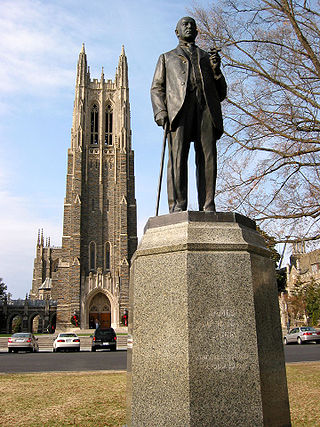
Charles Keck was an American sculptor from New York City, New York.

The Soldiers and Sailors Monument is a monument erected in Boston Common in downtown Boston, dedicated to soldiers and sailors of the Commonwealth of Massachusetts who died in the American Civil War. Designed by Martin Milmore, construction began in 1874 and the monument was dedicated on September 17, 1877. Union Generals George B. McClellan and Joseph Hooker were among the estimated 25,000 people attending the dedication on Boston Common.

Robert Tait McKenzie was a Canadian physician, educator, sculptor, athlete, soldier and Scouter. Born in Ramsay Township, Lanark County, Ontario, Canada, he attended McGill University in Montreal as an undergraduate and medical student, and was an instructor in its medical school beginning in 1894. In 1904, he moved to the United States to teach at the University of Pennsylvania in Philadelphia, Pennsylvania. In the 1930s, he returned to the county of his birth, retiring to the Mill of Kintail in Almonte.

Horace Trumbauer was a prominent American architect of the Gilded Age, known for designing residential manors for the wealthy. Later in his career he also designed hotels, office buildings, and much of the campus of Duke University.
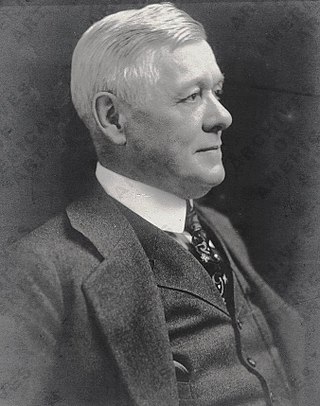
John Massey Rhind was a Scottish-American sculptor. Among Rhind's better known works is the marble statue of Dr. Crawford W. Long located in the National Statuary Hall Collection in Washington D.C. (1926).

Edgar Fahs Smith was an American scientist who is best known today for his interests in the history of chemistry. He served as provost of the University of Pennsylvania from 1911 to 1920, was deeply involved in the American Chemical Society and other organizations, and was awarded the Priestley Medal in 1926.

William Shakespeare has been commemorated in a number of different statues and memorials around the world, notably his funerary monument in Stratford-upon-Avon ; a statue in Poets' Corner in Westminster Abbey, London, designed by William Kent and executed by Peter Scheemakers (1740); and a statue in New York's Central Park by John Quincy Adams Ward (1872).
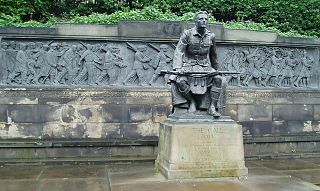
The Scottish American Memorial, or Scots American War Memorial, is in West Princes Street Gardens in Edinburgh. It was called "The Call 1914", and it was erected in 1927 and shows a kilted infantryman looking towards Castle Rock. Behind the main statue is a frieze showing queues of men answering the call by following a kilted pipe band. The memorial was given by Scottish-Americans to honour Scots who had served in the first World War.

Major General George Henry Thomas, also known as the Thomas Circle Monument, is an equestrian sculpture in Washington, D.C. that honors Civil War general George Henry Thomas. The monument is located in the center of Thomas Circle, on the border of the downtown and Logan Circle neighborhoods. It was sculpted by John Quincy Adams Ward, best known for his work on the statue of George Washington in Wall Street, Manhattan. Attendees at the dedication in 1879 included President Rutherford B. Hayes, Generals Irvin McDowell, Philip Sheridan, and William Tecumseh Sherman, senators and thousands of soldiers.

A bronze statue of a seated Benjamin Franklin by John J. Boyle is installed at the University of Pennsylvania in Philadelphia, Pennsylvania. It is located in front of College Hall, on Locust Walk, between 34th and 36th Streets, and is one of three statues of Franklin on the campus.

Samuel Gross (1897) is a bronze statue by sculptor Alexander Stirling Calder that was created as a monument to the American surgeon Dr. Samuel D. Gross (1805–1884). It was commissioned for and originally installed at the Army Medical School in Washington, D.C., on what is now the National Mall.

Lincoln Monument (Philadelphia) is a monument honoring Abraham Lincoln in Fairmount Park, Philadelphia, Pennsylvania, United States. One of the first initiated in memory of the assassinated president, the monument was designed by neoclassical sculptor Randolph Rogers and completed in 1871. It is now located northeast of the intersection of Kelly Drive and Sedgley Drive, opposite Boathouse Row.

The Ideal Scout, also known as The Boy Scout, is the most famous work by Canadian sculptor R. Tait McKenzie (1867–1938). The original statue stood in front of the Cradle of Liberty Council at 22nd and Winter Streets in Philadelphia, Pennsylvania, from 1937 to 2013. Replicas can be found at Boy Scouts of America councils across the United States, as well as at Gilwell Park in London, England, and at Scouts Canada's national office in Ottawa. The Smithsonian American Art Museum's database lists 18 copies.

The Quadrangle Dormitories are a complex of 39 conjoined residence houses at the University of Pennsylvania, in Philadelphia, Pennsylvania, United States. The architectural firm of Cope and Stewardson designed the houses in an exuberant Neo-Jacobean version of the Collegiate Gothic style, and completed most of them between 1894 and 1912. The dormitories stretch from 36th to 38th Streets and from Spruce Street to Hamilton Walk. West of the Memorial Tower at 37th Street, the houses on the north side follow the diagonal of Woodland Avenue and form a long triangle with the houses on the south side. From 1895 to 1971, the dormitories housed only male students.
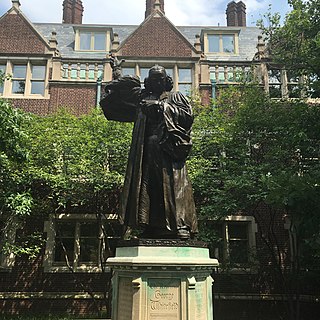
The Reverend George Whitefield is a monumental statue which once stood on the campus of the University of Pennsylvania in Philadelphia, Pennsylvania, United States. Dedicated in 1919, it was designed by sculptor R. Tait McKenzie and honors its namesake George Whitefield, Anglican cleric who was a founder of Methodism. In 2020, in reaction to the George Floyd protests, the university administration removed the statue due to Whitefield's defense of slavery.

Ezra Cornell is a monumental statue in Ithaca, New York, United States. Located on the Arts Quad of the Cornell Central Campus, the monument honors Ezra Cornell, the co-founder and namesake of Cornell University. The statue, designed by Hermon Atkins MacNeil, was dedicated in 1919.
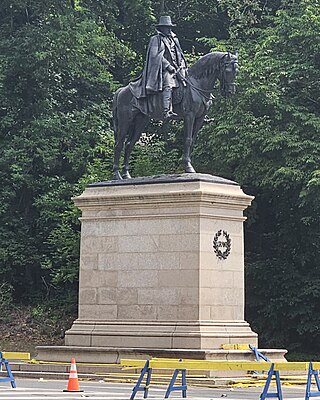
The equestrian statue of Ulysses S. Grant is a public monument in Philadelphia, Pennsylvania, United States. Located in Fairmount Park, the monument honors Ulysses S. Grant, who served as a general in the Union Army during the American Civil War and later as President of the United States. The monument was designed by Daniel Chester French and Edward Clark Potter and consists of an equestrian statue atop a pedestal. The statue was dedicated in 1899.

Marquis de Lafayette is a monumental statue on the campus of Lafayette College in Easton, Pennsylvania. The statue, designed by Daniel Chester French and standing on a pedestal designed by Henry Bacon, was dedicated in 1921 in honor of the college's namesake, Gilbert du Motier, Marquis de Lafayette. The statue is located at the south entrance of Colton Chapel. It is one of a number of sculptures made by French for universities, which includes the statue of John Harvard at Harvard University and Alma Mater at Columbia University.

Major General David McMurtrie Gregg is a monumental statue located in Reading, Pennsylvania, United States. The monument was designed by Henry Augustus Lukeman and consists of an equestrian statue depicting David McMurtrie Gregg, a military officer who had served in the Union Army during the American Civil War. The monument was dedicated in 1922, several years after Gregg's death in Reading in 1916.






















